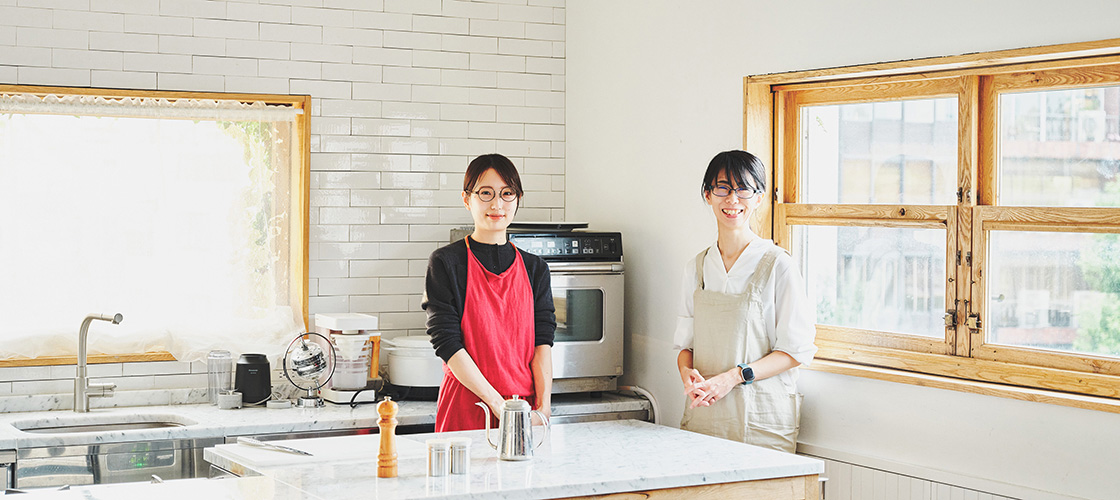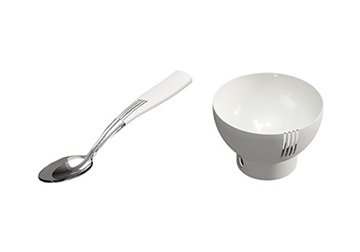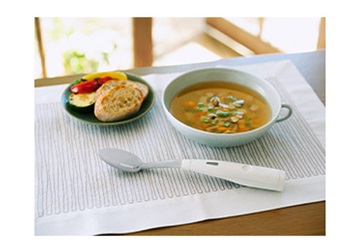Thinking about the future of FoodTech with Akari Hasegawa. How will Electric Salt Spoon change the dining table? Akari Hasegawa / Chef, Registered Dietitian
Ai Sato / Electric Salt Spoon Development, New Business Group, Health Science Business Department
Easy to prepare, tasty, and fulfilling for both mind and body. In today's world, where everyone lives a busy life, there is a demand for a rich diet that incorporates such elements in a well-balanced manner.
Electrical Salt Spoon is a spoon-shaped device with new technology that amplifies salty and umami tastes with the power of electricity, using technology developed in a joint research project between Kirin and the Yoshiaki Miyashita Laboratory of Meiji University. It was released as a tool to change the food of people who are conscious of their health and beauty, as well as those who are trying to reduce salt as part of their diet.
As the saying goes, "Cooking is the most accessible science," and both cooks and researchers are alike because they work to find the best formula through repeated experimentation. In this interview, Ai Sato of the Health Science Business Department, who was in charge of the development of Electric Salt Spoon, and Akari Hasegawa, a chef known for her "Itawari Gohan," a meal to support the body and mind, discuss the future of food.
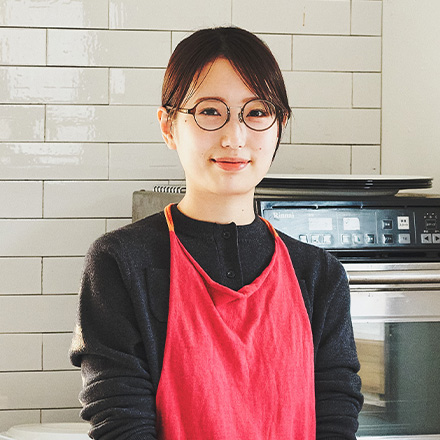
Akari Hasegawa
Chef and Registered Dietitian
Akari Hasegawa was born in 1996 in Saitama Prefecture. After working as an actor and TV personality, Akari Hasegawa studied nutrition at university, and in 2022 started transmitting information as a chef and registered dietitian. She is now active in a variety of fields. Her simple and abundant original recipes posted on social media have become a topic, and she has provided recipes to magazines and websites, developed menus with companies, and published cookbooks. She is the author of "Itawari Gohan: Deliciously Satisfy Your Tired Mind and Body," "Tsukuritakunaru Hibi Recipes," etc. Her new book "Itawari Gohan 2: Otsukare-sama Recipe Book for Tonight," was released in March.
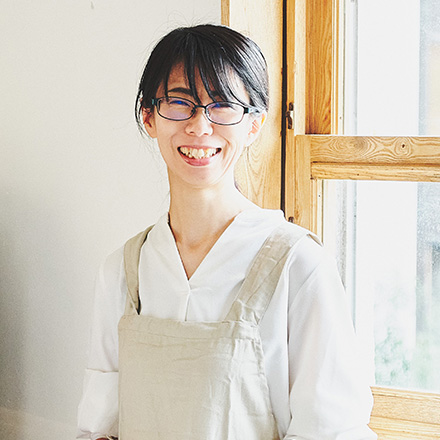
Ai Sato
Electric Salt Spoon Department, New Business Group, Health Science Business Department
After receiving a master's degree from the Graduate School of Agricultural and Life Sciences at the University of Tokyo, Sato joined Kirin Holdings in 2010. She has been engaged in research and development in Kirin's Food & Beverages domain, including soft drinks and new food ingredients, etc. In 2019, she took part in developing Electric Salt Spoon in Kirin’s collaboration with Yoshiaki Miyashita Laboratory of Meiji University. In the same year, the spoon was selected for the Kirin Group's internal new business support program, and a project to commercialize the product started. 2024 will see the release of the Electric Salt Spoon home-use model.
Contents
- Sick, pre-disease, and healthy. Taste and nutrition are necessary for all people
- Leaving blank spaces in recipes on purpose. I want people to complete the flavor in their own way.
- Enrich your diet while reducing salt content with electric taste sensation technology.
- The possibilities will expand depending on your ideas. A future with Electric Salt Spoon
- Increasing the number of food choices to meet the needs of this age of wanting it all
Sick, pre-disease, and healthy. Taste and nutrition are necessary for all people
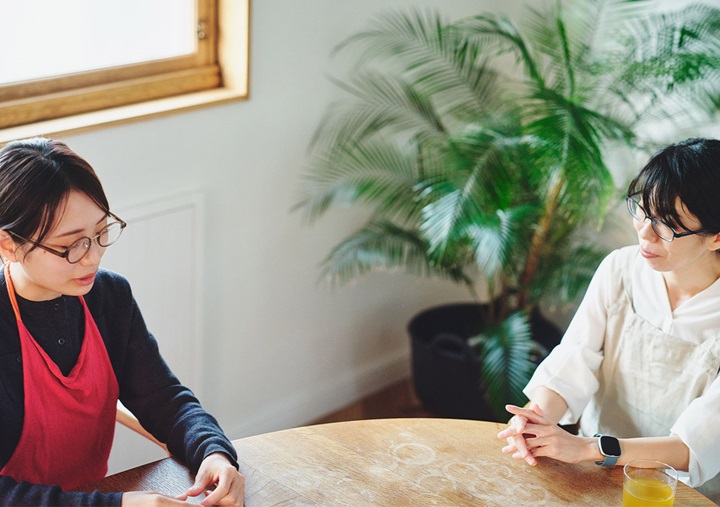
Sato: Thank you for joining us today. I joined Kirin in 2010 and have been involved in research and development that will lead to new businesses, not limited to beverages. In 2019 I submitted a business proposal for Electric Salt Spoon, which passed an internal contest, and we have been working to commercialize Electric Salt Spoon from 2020.
We originally developed Electric Salt Spoon to help people on salt reduction therapy enjoy their meals more, but we are now exploring its potential as a tool to expand the enjoyment of everyday meals as well. I always look forward to your gentle and enjoyable recipes on social networking websites, so I am looking forward to hearing about them today.
How did you become a cookery researcher, Hasegawa-san?
Hasegawa: I had always loved cooking, so I went on to a university where I could qualify as a registered dietitian. The most interesting class was Nutrition Science. However, I was more interested in preventing illness in healthy people and improving their health than in nutrition, which has a clear approach to pathological conditions.
Sato: So, you didn't always want to be a cookery researcher, did you?
Hasegawa: No. In fact, there was a time when I was active as a child actor, and I thought that communicating about food with such influence, however small it might be, might itself lead to public nutrition(*). So I thought, "What kind of job is close to what I want to do?" and what came to mind was a cookery researcher.
Public Nutrition...a subject in which students learn the knowledge necessary to support the health of local residents through nutrition and diet.
I had an image of being formal when it came to communicating about nutrition. Even correct nutritional knowledge must be easy to understand and fun, otherwise it is difficult to reach the young people it is intended to reach. However, if you try to be catchy, the information may be a bit extreme, such as "eat this and you will get rid of acne." I hope that by using the familiar medium of recipes to introduce the food and say, "Try this, it's delicious," the nutritional condition of the viewer’s body will naturally improve as well.
Sato: It is true that many of your recipes sound delicious and are things people would want to try. The recipes are really simple, so it is easy to incorporate them into real life. I myself am a very lazy person, so I am very grateful to have someone like you who offers tips on how to enjoy life in an easy way.
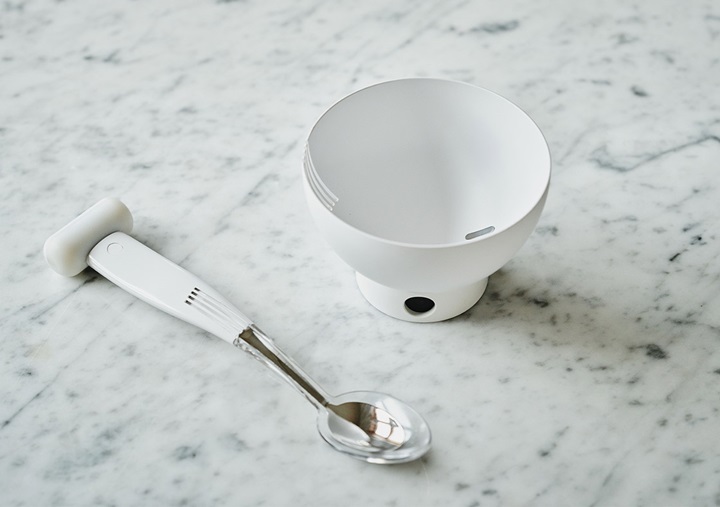
Left: Electric Salt Spoon (experimental machine), Right: Electric Salt Bowl (experimental machine). *The shape differs from that of the machine for sale.
The Electric Salt Spoon business started out as a way to help people who need to reduce salt consumption due to illness enjoy their meals more, but we changed our business policy midway through the project after rethinking the need to be aware of the importance of salt reduction at the stage of pre-disease and prevention. If we become too instructive by just saying "for sickness and for health," we would sound boring. I think it is more important to convey the fun and excitement of food. In that sense, I have been referring to your recipes and way of communicating.
Hasegawa: Thank you, I am glad to hear that. Like myself, even if I say to healthy people, "Let's reduce salt," it is difficult for them to put it into practice. That is why I am usually conscious of communicating in a way that even people who are not so interested in nutrition can enjoy.
Leaving blank spaces in recipes on purpose. I want people to complete the flavor in their own way.

Do you pay attention to the combination of ingredients, the use of seasonings, and other aspects of flavor creation?
Hasegawa: When I publish a recipe, I don't share what I think deserves a perfect score, but rather 70 to 80%. Some people may find it a bit lacking, but for some people, it may be enough to make them realize, "Hey, I usually use a stronger seasoning, but this simple seasoning is delicious enough." Whether eating out or cooking for yourself, you usually aim for a perfect score of 100, but if you aim for 120 for every meal, you will get tired.
Of course, if it is not enough, you can adjust it by adding saltiness or acidity to your taste, but don't you think that having room for creativity makes you feel more like "I made it" and makes you enjoy cooking? The direction of taste is clearly communicated, but I want the rest of the recipe to be free, so I leave room for people to arrange it in their own way, which is my way of creating the taste.
Sato: When I cook while following a recipe, I often make it without measuring it too closely. If it is not enough, I add seasonings and decide the taste in my own way. When I learned that your recipe was not full-maximized, I thought it was more worthwhile to arrange it.
Hasegawa: That's right. I hope you can refer to the recipe and get to know the essence of the dish, even if you don't follow the recipe exactly. Some of the overwhelmingly delicious food have a strong impact on you, but once you eat it, you don’t want to eat it for a while. If it is 70-80% delicious, the first bite may be "too thin," but by the time you finish it, you may be satisfied with the taste and think, "I want to eat it again tomorrow." It will not be a burden on your body. My goal is to create something that people can make as their daily meal.
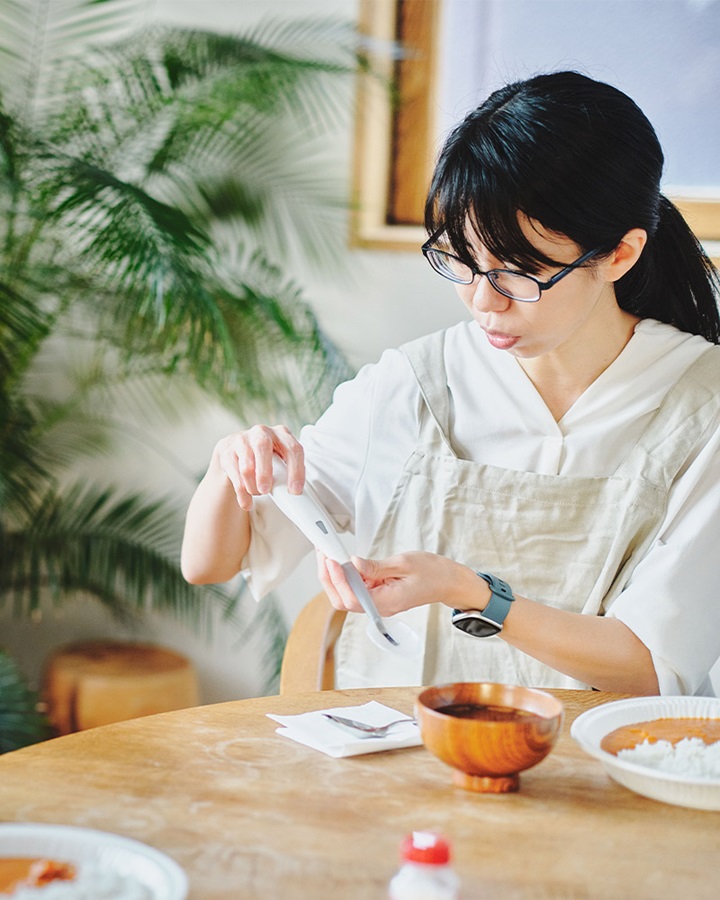
Sato: It is important to have just the right balance of deliciousness and health. Even with healthy food, if the taste is not satisfying, you will not be able to eat well and will lose energy. On the other hand, if the food tastes good but contains too much salt and calories, it will be hard on your body. We have been thinking of "something that can be used for daily meals without sacrificing taste and enjoyment" as a way to use Electric Salt Spoon.
Hasegawa: If you incorporate both deliciousness and health, it might become difficult to capture the hearts of either of the interest groups, so I think the point is to make a slightly fashionable proposal. We can try to balance the two by adding elements of a rich diet and lifestyle, such as, "It is more wonderful to feel the sweetness of vegetables than to add seasonings to make them taste strong."
Meals are a daily thing, so it is important to have a good balance. So there is no need to recreate the taste of eating out at home, and I like something that treats me. If there is a little bit of niceness and just the right amount of seasoning there, I think you can enjoy your meals.
Enrich your diet while reducing salt content with electric taste sensation technology.
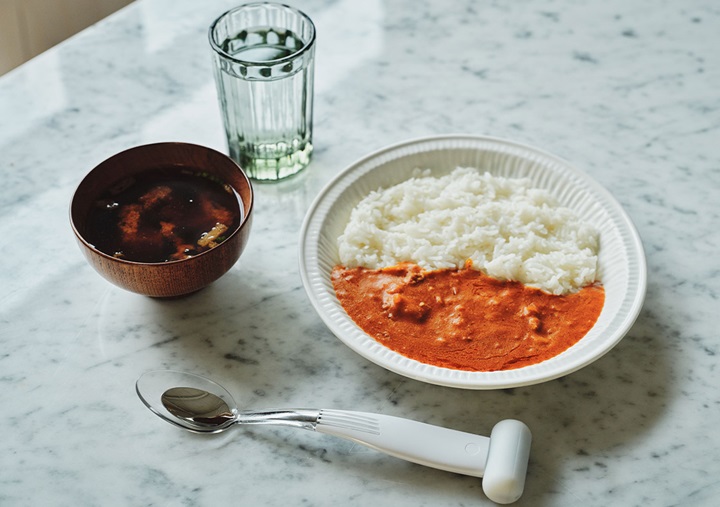
The Electric Salt Spoon is an experimental machine and its shape differs from that of the machine for sale.
Sato: Today, I would like to ask you to actually use the Electric Salt Spoon device while having a taste. It may not suit your diet, but since it is an electric current device, it is easy to see the effect of soup after all. It's fine as long as there is an electric current, but when the current finishes flowing, the effect also stops, so meat, for example, goes back to its original taste while being chewed. I have found that meals that stay in the mouth for a short time are better suited for Electric Salt Spoon.
To use the Electric Salt Spoon, the user selects the intensity of the electric current, which has four levels, with a button, and eats the food so that the food touches the electrode on the tip of the device. By doing so, a current flow is created from the food, through the tongue, through the arm, and back to the food again. This technology is called "electric taste," and it is a mechanism that enhances saltiness and other tastes by passing a weak electric current that has no effect on the human body.
While checking the original taste as well, try tasting the miso soup starting with a weak electric current. If you drink the soup by dipping the spoon into the soup as long as possible, you will be able to easily notice the change in taste.

Hasegawa: Wow, that's more future than I imagined! Yes, it is true that the weight of the salt on your tongue may be different if you drink it with Electric Salt Spoon. It's like miso soup at a pork cutlet restaurant, and the taste is quite strong. It doesn't taste tangy at all, just plain delicious.
Sato: If you press the button and change the intensity of the electric current in four levels, you can make it feel even thicker. It uses very weak electricity, so the effect varies from person to person and from dish to dish. Curry and rice as well as stew are two dishes that I personally think go well with the spoon, but today I have also prepared an unsalted butter chicken curry and rice, so please try this one as well.
Hasegawa: This is the first time I've had unsalted curry and rice, and it's delicious as is. It is interesting that the Electric Salt Spoon makes the tomato flavor so much richer. It seems to amplify the overall flavor.
Sato: Yes, it does. For dishes without saltiness, I imagine that the acidity and umami become more intense. Next, sprinkle a little salt on it and try it as a low-sodium curry and rice.

Hasegawa: Yes, it is very tasty. It is only lightly sprinkled with salt, so if you eat it with a regular spoon, it tastes weak, but with Electric Salt Spoon, it tastes like the curry and rice you usually eat. The change in taste may be easier to notice than with miso soup. If you sprinkle salt on the surface of the curry rather than mixing it in, I think you can feel the saltiness more strongly. It is so delicious that I wish they would sell it as a set with salt-free curry and rice.
Sato: I think it works better with rather complex flavors like curry and rice. It's called Electric Salt Spoon, but it also excels at umami and acidity. The presence or absence of a salty base also changes the effect of the enhancement, so I think that if you use it in various ways at home, you can enjoy it in a richer way. When we had customers try it out during the demonstration test, some of them used it in sweets such as oshiruko (sweet red-bean soup).
The possibilities will expand depending on your ideas. A Future with Electric Salt Spoon
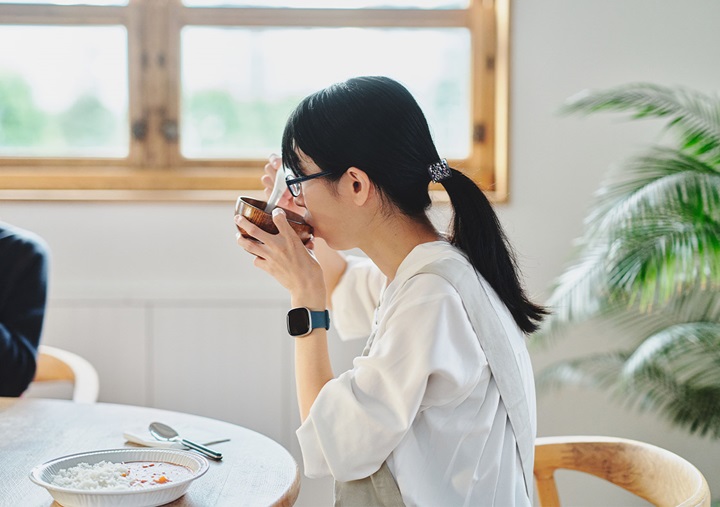
Was it a long road of development before you were able to create a device that could actually be used in this way?
Sato: Yes, it was. The first time I heard of it was when I heard from a doctor at a university hospital that he was "having difficulty getting patients to continue with their diet therapy." I also heard patients say, "I know it's important to reduce salt, but it's hard to keep going." So I tried it out myself, living on about 6 grams of salt per day for three months.
At first, I thought, "I might surprisingly be able to stay with it," but after three months, I gradually lost my appetite and strength, and I also lost about five kilograms of weight. I thought, "It's hard to continue this. This is harder than I imagined." I started looking for a way to improve the taste, which led to the development of this product.
The technology was originally researched at a university, and we started by trying it out on a handmade experimental machine. It was difficult until we were able to get the current to flow stably with actual meals. We also considered a chopstick-type device, but gave up on that because it did not work well, and settled on a spoon-type device.
Hasegawa: This was the first time I had heard of this kind of technology, and even though I understood it in theory, I wondered how it would fit into daily life. But the fact that it suits "meals that stay in the mouth for a short time" means that even if chewing strength declines with age, soft foods such as curry and porridge can be eaten with less salt and still taste good. Liquid meals have more weight to consume and tend to be more seasoned. They tend to have a higher salt intake compared to solid food. That's why it's so nice to be able to adjust with a spoon.
Sato: When we ask people who are trying to reduce salt intake what they want to eat, many of them mention curry and rice, and ramen noodles. I would be happy if Electric Salt Spoon could be an opportunity to enjoy food for those who feel they have a hurdle to overcome.
Hasegawa: Japanese people tend to take in too much salt, so I think they should use it even if they are healthy. In my generation, there are many people who cut back on salt to prevent swelling. I think it could be a beauty item like the anti-swelling spoon. How is that? You can make an adjustable meal if you lightly sprinkle salt on a nutritious vegetable soup and eat it with this spoon.
Sato: I am glad you actually tried this, and I got ideas that I would never have thought of myself.

Hasegawa: If I were to eat it with a spoon, it would go well with ethnic foods, such as Chinese or Korean food. I would like to try eating soup dumplings with it, and I would love to see you make a Chinese soup spoon shaped one as well.
I think it would also go well with baby food and toddler food, so adults can enjoy the same recipe by sprinkling a little salt on it and using Electric Salt Spoon. Many baby foods are made using only the umami of the ingredients, but in fact, many of my dishes are inspired by them.
Sato: I'm surprised that you think of baby food as a source of inspiration. The Chinese soup spoon shape would be easy to use, and your opinion is very helpful. It is an interesting experimental technology, and I am excited to see the possibilities of food expanding as people experiment with various menus and recipes. I am also thinking that it would be great if we could create a community of people who use Electric salt spoon and share compatible recipes and recommendations on how to use it there.
Increasing the number of food choices to meet the needs of this age of wanting it all

What do you think will be important when you think about food in the future?
Hasegawa: I think there will be changes in the times and trends. In my grandmother's generation, it was nothing special to have double income, so many of their meals were salted or pre-prepared. My mother's generation was in a period of high economic growth, and many of them were housewives, so the standard of food had risen, and Western-style and restaurant food had entered the home.
The next generation, ours, has less time to cook at home with high expectations for homemade food, but they also have to worry about their health, and they are familiar with the taste of luxury through eating out. So we are in an age where we want it all... delicious, healthy, easy, and fun... though we may be greedy. I myself want it all, and that is why I want to deliver just the right recipes that can satisfy all of these needs.
Sato: If you try to do everything perfectly, it will ruin your life. I think it is important to have just the right amount that you can sustainably and comfortably continue while working.
Hasegawa: If you try to have a perfect and overly rich diet, you will get tired. In this day and age, I feel that a well-balanced diet with a variety of elements is just right, rather than being too excessive. For example, even on days when you buy prepared foods, you can cook only the rice yourself. If we can adjust our diet without overdoing it, I think it will be easier on our minds.
It would be nice if you could find your own comfort zone without getting caught up in stereotypes such as the right way to eat. How recipes and new technologies are utilized depends on the person who uses them, and it may be completely different from what is expected. First of all, it is important that it fits in with one's lifestyle, which leads to physical and mental health. For a familiar example, it would be interesting if the Electric Salt Spoon becomes one of the choices for everyone, like the electric toothbrush.
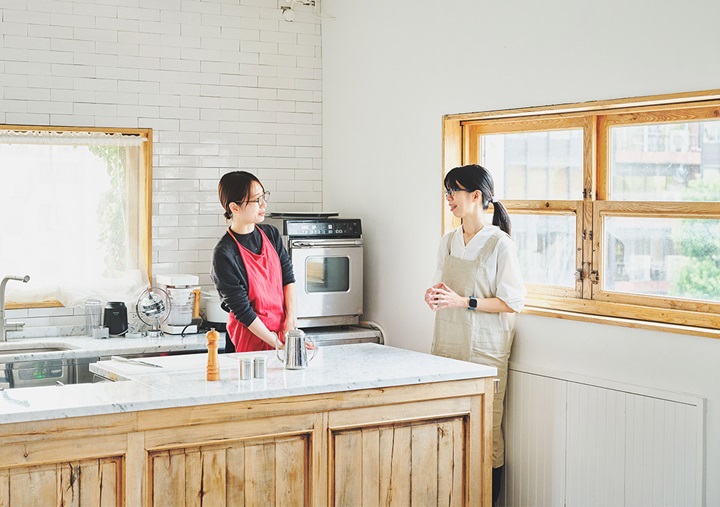
Sato: The value of enjoyment through food is universal in any age. I believe that new FoodTech and new essences will appear more and more in the food related industry, and I would like to support customers' enjoyment of food and their health through such things.
I would be happy if new technologies, such as Electric Salt Spoon, can be adopted if they suit customers and become one of the many options available to them.
Publication date: May 20, 2024
Content, affiliation, position, etc. are as of the time of publication
- Text by Mayu Sakazaki
- Photo by Eichi Tano
- Editing by Ai Hanazawa, RIDE Inc.


